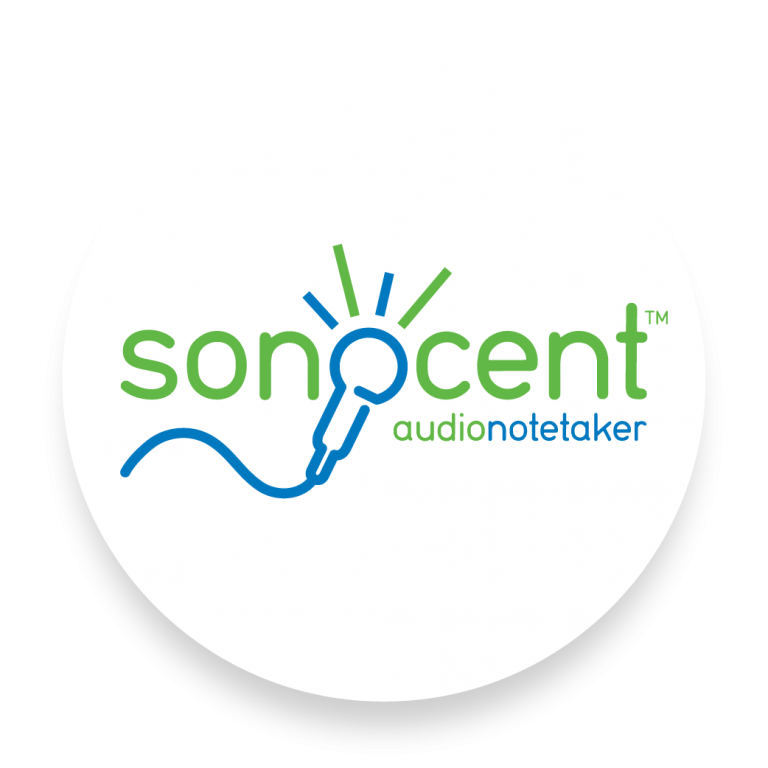
Supplementary Accommodations (Independent Accommodations) This resource is intended to help disability services professionals work with a more deliberate understanding of accommodations, strategies, and tools.
#SONOCENT AUDIO NOTETAKER APP HOW TO#
That should include not only critically deciding what types of accommodation are the right fit, but also providing some coaching on how to best use those accommodations with other note-taking strategies. Most likely, there is a combination of disability and strategy at play, and it makes it even more important that disability services professionals work to ensure that students with disabilities utilize effective accommodations and strategies to improve access. It is difficult to determine whether students’ concerns with note-taking are born out of disability or due to a lack of strategy and experience as a notetaker. Note-taking accommodations are an increasingly important topic that require thoughtful discussion, but we often ignore it so that we may focus on seemingly riskier and more challenging issues. Note-taking Accommodations and Technology: The Basics (Part II) Beginning below and extending into the next edition of the Hub, we are pleased to share a summary of issues and resources pertinent to note-taking accommodations from Paul Harwell of Texas A&M University. New teaching styles, database programs, and note-taking technologies are pushing us to reconsider what “note-taking” really is: what it means to experience a barrier related to capturing information during a class lecture and how we can set-up systems that encourage skill development while ensuring that students with disabilities are not excluded.
#SONOCENT AUDIO NOTETAKER APP PRO#
There are also more feature-rich recording apps such as the Conversor Pro app and the Sonocent Audionotetaker App, (designed to work with the PC / Mac version of Sonocent Audionotetaker).Increasingly, we hear members question how and to whom they provide note-taking accommodations. Although the quality might not be as good as a digital recorder, you can still get good results if you remember to sit at the front of the lecture theatre. If you don’t have a digital recorder, it might be worth seeing if you have a basic app built in to your phone that will allow you to make recordings.

Use your recordings with Dragon: If you own Dragon software, you can dictate directly into the recorder, load the audio file into Dragon and have the notes you dictated automatically converted into text.lecture, small meeting, or on your own – so that you can get the best recording quality. You choose the setting for the environment you are recording in – e.g. Get the best recording quality: Most Olympus recorders feature recording ‘scenes’ – i.e.Now, when you listen back to the lecture, you don’t have to fast-forward through the 20 minutes where the projector stopped working and everyone was talking amongst themselves! If there is an interruption to a lecture, just pause your recording. Pause function: A very simple, yet often overlooked tool.Imagine making a bookmark every time the slide changes – this makes it very easy to find the slide that you want to ‘listen to’ when you get home. (An audio file that is bookmarked is like an album with different tracks that you can skip through). Index Marks: Most Olympus recorders use index marks these are basically bookmarks that you can make in your recording while listening to the lecture.If you are just getting to grips with a digital recorder or are considering getting one – here are some important things to consider:

If you have received a digital recorder via a DSA application, you may have been given an Olympus DM770 or a similar recorder – these tools are designed to export to a PC or Mac running Olympus’s own Sonority software, but the files also work extremely well with Sonocent Audio Notetaker or Claro AudioNote. Sometimes it is easier to concentrate on listening and reading the physical act of writing notes can make it difficult to process information you are hearing in a way that you will remember. This is especially true if you have difficulty taking notes while listening to the lecturer and reading lecture slides at the same time. Using a digital recorder to record lectures and seminars is a strategy that can make a real difference to how much information you retain.


 0 kommentar(er)
0 kommentar(er)
